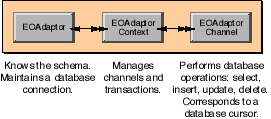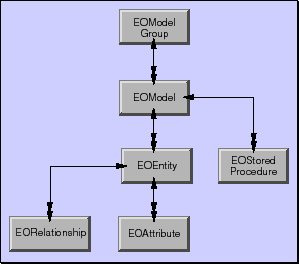 Table of Contents
Table of Contents  Previous Section
Previous Section
Classes in a Command-Line Program
A command-line program-one that doesn't have a graphical user interface-uses the most fundamental Enterprise Objects Framework classes (Figure 11). The same classes are used in all the most typical types of applications, but other types add other classes for interacting with the user interface.
Figure 11. Framework classes in a Command-Line Program

The Access Layer
The access layer is the part of the Framework that interacts with the database. Its role in a command-line program is much the same as it is in all other types: it fetches rows of data from a database, creates enterprise objects from the fetched data, and registers the enterprise objects with the control layer-the next layer up in an application's architecture. Later, when the control layer has changes to save, it directs the access layer to write those changes to the database.
- The adaptor level that interacts with a database in terms of server-specific client libraries, providing server-independent database access to the rest of the Framework.
- The database level that creates full-fledged enterprise objects from database rows.
- Modeling classes that furnish database login information and a database-to-objects mapping.
EOModel is one of the modeling classes. An EOModel object represents the whole database-to-objects mapping in entity-relationship terms, while other modeling classes correspond to components of that mapping. The adaptor level, database level, and modeling classes are described in greater detail in the following sections.
Figure 12. The Access Layer

The Adaptor Level
The adaptor level defines a server-independent interface for working with relational database systems. Figure 13 shows the adaptor level classes and the behaviors associated with each class.
Figure 13. Adaptor Level

The Database Level
The database level creates enterprise objects from the dictionaries retrieved by the adaptor level. It's also where snapshotting is performed. Snapshotting is used by Enterprise Objects Framework to manage updates. For caching, For updating, when an object is fetched from the database, a snapshot is taken of its state. A snapshot-an NSDictionary object-is consulted when you perform an update to verify that the data in the row to be updated has not changed since you fetched the object.
Figure 14. Database Level

Modeling Classes
The correspondence between an enterprise object class and stored data is established and maintained in a model. A model defines, in
entity-relationship terms, the mapping between enterprise object classes and a database. Figure 15 shows the modeling classes.
Figure 15. Modeling Classes

In addition to storing a mapping between the database schema and enterprise objects, an EOModel object stores information needed to connect to the database server. This connection information includes the name of the adaptor corresponding to your application's database server. An EOModel can also store information about a database's stored procedures (in EOStoredProcedure objects).
The Control Layer
In a command-line program, the control layer's responsibility is to manage a graph of enterprise objects, tracking changes to them and directing the access layer to commit those changes to the database when the program is ready to save. The control layer classes that perform these duties are EOObjectStoreCoordinator and EOEditingContext. An EOObjectStoreCoordinator object manages interactions with the access layer, while EOEditingContext objects manage graphs of enterprise objects and track changes to those objects. Interacting with the Access Layer
The control layer provides an infrastructure for managing enterprise objects that is independent of the storage mechanism being used. Put another way, you can use the control layer to interact with any external store: a relational database, a live data feed, or the file system, for example. To achieve this independence, the control layer defines an abstract class, EOObjectStore, whose subclasses represent "intelligent" sources and sinks of objects for EOEditingContexts. An object store is responsible for constructing and registering objects and for committing changes made in an editing context.
- EOCooperatingObjectStore, an abstract class that defines the basic API for object stores that work together to manage data from several distinct data repositories.
- EOObjectStoreCoordinator, a concrete class whose instances manages the interactions between editing contexts and cooperating object stores.
Object Graph Management and Change Tracking
An object graph is a group of related enterprise objects that represents an internally consistent view of an external store-typically a database. In a running application, the object graph is the central repository for data and business logic. An EOEditingContext object, which represents a single "object space" or "document" in an application, manages this in-memory graph of enterprise objects. All objects fetched from an external store are registered in an editing context with a global identifier (an EOGlobalID object) to uniquely identify each object. The editing context is then responsible for watching for changes in its objects and recording snapshots of them for object-based undo. For more information on change tracking, see the EOEditingContext class specification and the EOObserving interface (or protocol) specification in the Enterprise Objects Framework Reference.
 Table of Contents
Table of Contents  Next Section
Next Section